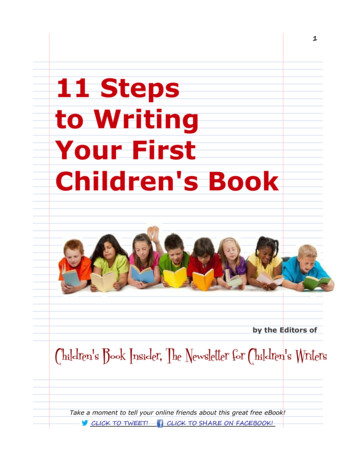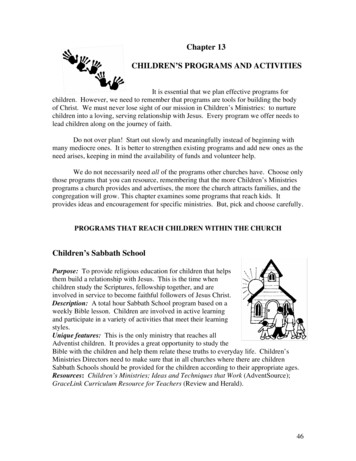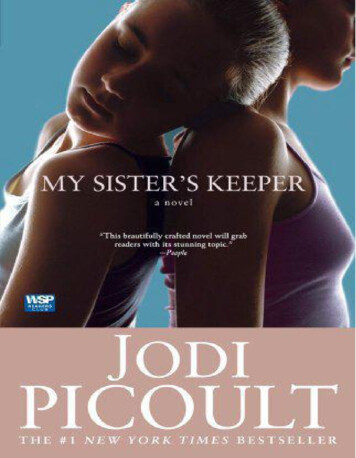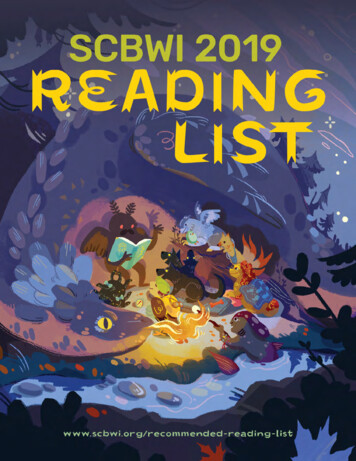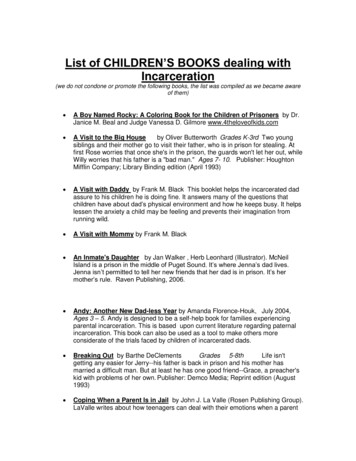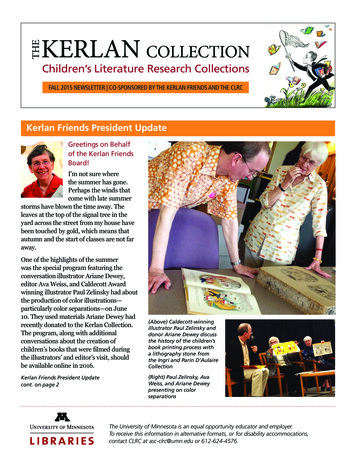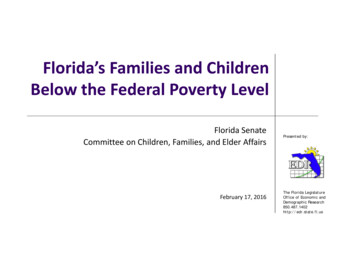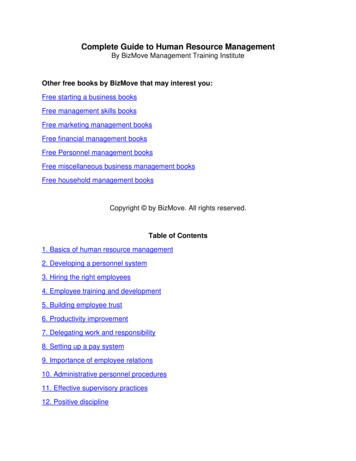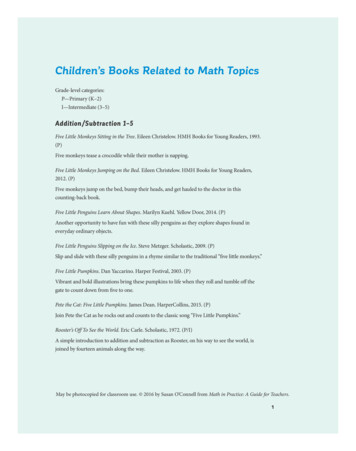
Transcription
Children’s Books Related to Math TopicsGrade-level categories:P—Primary (K–2)I—Intermediate (3–5)Addition /Subtraction 1–5Five Little Monkeys Sitting in the Tree. Eileen Christelow. HMH Books for Young Readers, 1993.(P)Five monkeys tease a crocodile while their mother is napping.Five Little Monkeys Jumping on the Bed. Eileen Christelow. HMH Books for Young Readers,2012. (P)Five monkeys jump on the bed, bump their heads, and get hauled to the doctor in this counting-back book.Five Little Penguins Learn About Shapes. Marilyn Kuehl. Yellow Door, 2014. (P)Another opportunity to have fun with these silly penguins as they explore shapes found ineveryday ordinary objects.Five Little Penguins Slipping on the Ice. Steve Metzger. Scholastic, 2009. (P)Slip and slide with these silly penguins in a rhyme similar to the traditional “five little monkeys.”Five Little Pumpkins. Dan Yaccarino. Harper Festival, 2003. (P)Vibrant and bold illustrations bring these pumpkins to life when they roll and tumble off thegate to count down from five to one.Pete the Cat: Five Little Pumpkins. James Dean. HarperCollins, 2015. (P)Join Pete the Cat as he rocks out and counts to the classic song “Five Little Pumpkins.”Rooster’s Off To See the World. Eric Carle. Scholastic, 1972. (P/I)A simple introduction to addition and subtraction as Rooster, on his way to see the world, isjoined by fourteen animals along the way.May be photocopied for classroom use. 2016 by Susan O’Connell from Math in Practice: A Guide for Teachers.1TG ONLINE child bks 6623.indd 14/13/16 1:08 PM
Addition /Counting 1–10A Collection for Kate. Barbara deRubertis. Kane Publishing, 1999. (P/I)As she adds up the items in the collections that some of her classmates bring to school, Katetries to come up with a collection of her own.A Fair Bear Share. Stuart J. Murphy. HarperCollins, 1998. (P/I)Four bear cubs collect ingredients for a blueberry pie, counting and recounting them (usingaddition with regrouping) as their supply grows.Animals on Board. Stuart J. Murphy. HarperCollins, 1998. (P)While driving her truck, Jill counts and then adds the number of animals that she sees on othertrucks as they pass her on the road.Dinner at the Panda Palace. Stephanie Calmenson. HarperCollins, 1995. (P/I)Mr. Panda, owner of the Panda Palace restaurant, manages to find seating for all of his animalpatrons on a very busy night.Fish Eyes. Lois Ehlert. Voyager/HBJ, 1990. (P)Brightly colored fish introduce children to counting and basic addition.Jack the Builder. Stuart J. Murphy. HarperCollins, 2006. (P)A child uses building blocks to show counting on.Mission Addition. Loreen Leedy. Holiday House, 1997. (P/I)Miss Prime and her class are on the case solving addition mysteries. Animals count objects,have a yard sale, buy lunch, and see how and how not to add.Monster Math Picnic. Grace Maccarone. Scholastic, 1998. (P)Count how many monsters are playing each of the different games at the monster math picnic!Mouse Count. Ellen Stoll Walsh. Harcourt Brace & Co., 1991. (P)Introduces the concept of counting forward and backward as ten mice outsmart a hungry snake.1, 2, 3, to the Zoo. Eric Carle. Philomel Books, 1996. (P)Students count animals in this simple counting book.May be photocopied for classroom use. 2016 by Susan O’Connell from Math in Practice: A Guide for Teachers.Children’s BooksTG ONLINE child bks 6623.indd 224/13/16 1:08 PM
One Watermelon Seed. Celia Lottridge. Fitzhenry and Whiteside, 2012. (P)Max and Josephine tend their garden while readers follow along, counting from one to ten asthe garden is planted.Quack and Count. Keith Baker. HMH Books for Young Readers, 2004. (P)Follow seven ducklings as they get ready to fly for the first time. Simple addition equations areincluded in the story.Ten Flashing Fireflies. Philemon Sturges. NorthSouth, 1995. (P)Count from one to ten as children catch ten fireflies, then count back ten to one as they let themgo one at a time.12 Ways to Get to 11. Eve Merriam. Simon and Schuster Books, 1993. (P)Uses ordinary experiences to present twelve combinations of numbers that add up to eleven.Ready, Set, Hop! Stuart J. Murphy. HarperCollins, 1996. (P/I)Explains equation building as two frogs count their hops to a rock, a log, and a pond.Rooster’s Off To See the World. Eric Carle. Scholastic, 1972. (P/I)A simple introduction to addition and subtraction as Rooster, on his way to see the world, isjoined by fourteen animals along the way.Safari Park. Stuart J. Murphy. HarperCollins, 2001. (P/I)Rides cost different amounts of tickets at Safari Park. Grandpa gives each grandchild twentytickets and they can use them for any combination of rides. Number sentences with variablesare presented (8 ? 20).The Smushy Bus. Leslie Helakoski. Millbrook Press, 2002. (P/I)A clever bus driver uses addition and subtraction to be sure that seventy-six children get on—and off—of the four-seat substitute bus.AlgebraDinosaur Deals. Stuart J. Murphy. HarperCollins, 2001. (P/I)Mike and Andy do some wheeling and dealing at the Dinosaur Card Trading Fair and find thatone of one type of card might equal three of another.May be photocopied for classroom use. 2016 by Susan O’Connell from Math in Practice: A Guide for Teachers.3TG ONLINE child bks 6623.indd 3Children’s Books4/13/16 1:08 PM
Safari Park. Stuart J. Murphy. HarperCollins, 2001. (P/I)Rides cost different amounts of tickets at Safari Park. Grandpa gives each grandchild 20 ticketsand they can use them for any combination of rides. Number sentences with variables are presented (8 ? 20).AreaBigger, Better, Best! Stuart J. Murphy. HarperCollins, 2002. (P/I)Jenny and Jeff argue over who has the biggest room and measure their windows and floor usingsheets of paper and newsprint.Sam’s Sneaker Squares. Nat Gabriel. The Kane Press, 2002. (P/I)With his brother’s help, Sam figures out how to measure the sizes of the lawns he mows using abasic understanding of area.Attributes—Sorting and ClassifyingA Pair of Socks. Stuart J. Murphy. HarperCollins, 1996. (P)Introduces attributes as a sock searches the house for its match.The Button Box. Margarette S. Reid. Puffin Books, 1990. (P/I)A little boy plays with the buttons in his grandmother’s button box and explores their differences and similarities.Dave’s Down-to-Earth Rock Shop. Stuart J. Murphy. HarperCollins, 2000. (P/I)As they consider sorting their rock collection by color, size, type, and hardness, Josh and Amylearn that the same objects can be organized in many different ways.Frog and Toad Are Friends. “A Lost Button.” Arnold Lobel. HarperTrophy, 1970. (P/I)Toad lost a button from his jacket and his friends try to find it. They find many types of buttons;however, the size, shape, color, and number of holes are never right.Grandma’s Button Box. Linda Williams Aber. The Kane Press, 2002. (P/I)When she spills her grandmother’s button box, Kelly and her cousins try to sort them by size,color, and shape and they earn Grandma’s gratitude.Is It Larger? Is It Smaller? Tana Hoban. Greenwillow Books, 1997. (P)Photographs of animals and objects in larger and smaller sizes are compared.May be photocopied for classroom use. 2016 by Susan O’Connell from Math in Practice: A Guide for Teachers.Children’s BooksTG ONLINE child bks 6623.indd 444/13/16 1:08 PM
Is It Red? Is It Yellow? Is It Blue? Tana Hoban. Greenwillow Books, 1997. (P)Illustrations and brief text introduce colors and the concepts of shape and size.More, Fewer, Less. Tana Hoban. Greenwillow Books, 1998. (P)Photographs illustrate groupings of objects in larger and smaller numbers.3 Little Firefighters. Stuart J. Murphy. HarperCollins, 2003. (P)It’s parade day for three little firefighters and they have to look their best, but their coats aremissing buttons. They get out a button box and try to sort them to find buttons for each coat.CapacityA House for Birdie. Stuart J. Murphy. HarperCollins, 2004. (P)Birdie’s friends help him find a house that fits just right, rather than one that is too tall, too wide,too fat, or too short.LuLu’s Lemonade. Barbara deRubertis. The Kane Press, 2000. (P/I)On a hot summer day, three children squabble over which ingredients and what quantitiesshould go into their extra special lemonade.Me and the Measure of Things. Joan Sweeny. Scholastic, 2001. (P/I)A little girl shows how she uses weights and measures throughout the course of her day fromteaspoon, tablespoon, and cup to pints, quarts, bushels, and pecks.Pigs in the Pantry: Fun with Math and Cooking. Amy Axelrod. Simon & Schuster, 1999. (P/I)Mr. Pig and the piglets try to cook Mrs. Pig’s favorite dish to cheer her up when she’s sick.Includes a recipe for chili.Room for Ripley. Stuart J. Murphy. (Mathstart Series) HarperCollins, 1999. (P/I)This story about a young boy who is getting his fish bowl ready for his new pet introducesvarious units of liquid measure.The Case of the Shrunken Allowance. Joanne Rocklin. Scholastic (Hello Math Reader),1998. (P/I)Mike and his friends try to figure out why the money in his allowance jar appears tobe shrinking.May be photocopied for classroom use. 2016 by Susan O’Connell from Math in Practice: A Guide for Teachers.5TG ONLINE child bks 6623.indd 5Children’s Books4/13/16 1:08 PM
Comparing NumbersAlbert Keeps Score. Daphne Skinner. Kane Press, 2012. (P)Albert wants to make sure that his big sister, Wanda, never gets more of anything than he does.So he carefully keeps score and discovers that sometimes zero is better than one!Counting Cockatoos. Stella Blackstone. Scholastic, 2006. (P)Count the creatures 1–12. On each page also find two cockatoos. Are there more cockatoos ormore of the other animals?Just Enough Carrots. Stuart J. Murphy. HarperCollins, 1997. (P)A bunny and his mother shop in a grocery store for lunch guests, and readers can count andcompare the amounts of carrots, peanuts, and worms in the grocery carts of other shoppers.More or Less. Stuart J. Murphy. HarperCollins, 2005. (P)Eddie has a booth at the school fair, guessing people’s ages. He hasn’t guessed wrong yet, but ifhe does, he gets dunked.Coordinate GridsThe Fly on the Ceiling. Dr. Julie Glass. Random House, 1998. (I)A story about how Rene Descartes invented a way of keeping track of his possessions usinga grid.Counting—Basic Number ConceptsBears at the Beach: Counting 10 to 20. Niki Yektai. Scholastic, 1996. (P)Count the beach items 10–20.Count on Pablo. Barbara deRubertis. Kane Publishing, 1999. (P)Pablo demonstrates how good he is at counting while helping his grandmother, his “abuela,”prepare to sell vegetables at the market.Counting Cockatoos. Stella Blackstone. Scholastic, 2006. (P)Count the creatures 1–12.Counting Crocodiles. Judy Sierra. Scholastic Inc, 1997. (P/I)A monkey wants to get the bananas on the other side of the island and jumps over crocodiles toget there, counting each one as he jumps.May be photocopied for classroom use. 2016 by Susan O’Connell from Math in Practice: A Guide for Teachers.Children’s BooksTG ONLINE child bks 6623.indd 664/13/16 1:08 PM
Deep in the Swamp. Donna Bateman. Scholastic, 2007. (P)Learn about and count swamp creatures 1–10. Includes facts about swamp flora and fauna.Dinner at the Panda Palace. Stephanie Calmenson. HarperCollins, 1995. (P/I)Mr. Panda, owner of the Panda Palace restaurant, manages to find seating for all of his animalpatrons on a very busy night.Feast for 10! Cathryn Falwell. Houghton Mifflin, 1995. (P/I)Numbers from one to ten are used to tell how members of a family shop and work together toprepare a meal.Fish Eyes. Lois Ehlert. Harcourt, 1990. (P)A counting book showing schools of colorful fish from one to ten.From One to One Hundred. Teri Sloat. Puffin, 1995. (P/I)Illustrations of people and animals introduce the numbers one through ten and then, countingby tens, move on up to one hundred.Henry Keeps Score. Daphne Skinner. The Kane Press, 2001. (P)Henry wants to make sure that his older sister never gets more of anything than he does sohe carefully keeps score until Harriet gets a cavity and he gets none and Henry discovers thatsometimes zero is better than one.How Many, How Many, How Many. Rick Walton. Candlewick Press, 1993. (P)The reader counts from one to twelve while guessing the answers to questions about nurseryrhymes, names of the seasons, players on a football team, and other basic information.How Many Snails? Paul Giganti Jr. Morrow, William & Co., 1994. (P/I)A young child takes walks to different places and wonders about the amount and variety ofthings seen on the way.Look! Jeff Mack. Philomel Books, 2015. (P)A gorilla tries silly antics to get the attention of a little boy who is watching TV.Math Appeal. Greg Tang. Scholastic, 2003. (P/I)Uses math riddles to test students’ problem-solving and arithmetic skills.May be photocopied for classroom use. 2016 by Susan O’Connell from Math in Practice: A Guide for Teachers.7TG ONLINE child bks 6623.indd 7Children’s Books4/13/16 1:08 PM
Monster Math. Grace Maccarone. Scholastic, 1995. (P)Rhyming text and illustrations follow the activities of a group of twelve monsters that diminishes one by one.One Gorilla. Atsuko Morozumi. Farrar, Straus & Giroux, 1993. (P/I)One very playful gorilla keeps popping up in gardens, forests, jungles, and even people’s housesas he takes the reader on a wild counting adventure.One Monkey Too Many. Jackie French Koller. Scholastic, 1999. (P)One more monkey keeps joining different groups making it one monkey too many.One Watermelon Seed. Celia Barker Lottridge. Stoddart Publishing, 1997. (P)Pictures and simple words describe the work and fun of two children as they make a garden andthen harvest the fruits and vegetables they have grown.Only One. Marc Harshman. Dutton Children’s Books, 1993. (P)At a county fair, there are one million stars in one sky, one hundred patches in one quilt, tencents in one dime, seven peas in one pod, four wheels on one wagon, and so on.Splash! Ann Jonas. Greenwillow Books, 1997.Count the animals that fall into the pond and climb out.Spunky Monkeys on Parade. Stuart J. Murphy. HarperCollins, 1999. (P/I)In the Monkey Day Parade, monkey majorettes, cyclists, tumblers, and band members create aspectacle as they move along in groups of two, three, and four.Ten Apples Up on Top. Theo LeSieg. Random House, 1961. (P)A rhyming book about animals counting how many apples they can balance on their headswhile doing other things such as jumping rope, eating, and climbing.Ten, Nine, Eight. Molly Bang. Morrow, William & Co., 1991. (P)Numbers one through ten are part of this lullaby, which observes the room of a little girl goingto bed.Twenty Big Trucks in the Middle of the Street. Lee Mark. Candlewick Press, 2013. (P)An ice-cream truck breaks down in the middle of the street and causes a traffic jam.May be photocopied for classroom use. 2016 by Susan O’Connell from Math in Practice: A Guide for Teachers.Children’s BooksTG ONLINE child bks 6623.indd 884/13/16 1:08 PM
The Night Before the 100th Day of School. Natasha Wing. Grosset & Dunlap, 2005. (P)The one hundredth day of school is almost here and one student is desperate to find onehundred of anything to bring to class.Two of Everything. Lily Toy Hong. Albert Whitman, 1993. (P/I)A poor old Chinese farmer finds a magic brass pot that doubles, or duplicates, whatever isplaced inside it, but his efforts to make himself wealthy lead to unexpected complications.Two Ways to Count to Ten. Ruby Dee. Henry Holt & Co., 1988. (P/I)This Liberian folktale tells the story of jungle animals as they determine who will be the newking. The animal who can count to ten before a spear hits the ground will be king. A cleveranimal wins by skip counting.What Comes in 2’s, 3’s, and 4’s? Suzanne Aker. Simon & Schuster, 1992. (P)Introduces the numbers two, three, and four by enumerating the ways in which they occur ineveryday life, from two eyes and two arms to the four seasons of the year.When Sheep Cannot Sleep. Satashi Kitamura. Farrar, Straus & Giroux, 1986. (P)When Wooly the sheep suffers from insomnia, he goes for a walk and gets into just about everything. Each illustration features objects for children to count.The Wolf ’s Chicken Stew. Keiko Kasza. G. P. Putnam’s Sons, 1987. (P)A hungry wolf attempts to fatten a chicken for his stew by bringing her one hundred pancakes,one hundred doughnuts, and a cake weighing one hundred pounds but is surprised by what hefinds at her house.Zero. Kathryn Otoshi. KO Kids Books, 2010. (P)Zero is sad because she doesn’t have value like the other numbers but learns a lesson in thisstory about number values.Zero Is the Leaves on the Tree. Betsy Franco. Tricycle Press, 2009. (P)What does zero look like? It looks like the leaves on a tree in winter. Explore other examples thatshow the quantity zero.Counting Back Ten to One (Subtraction)Pete the Cat & His Four Groovy Buttons. Eric Litwin. Scholastic, 2013. (P)Count down with Pete as he loses groovy buttons off of his shirt one by one.May be photocopied for classroom use. 2016 by Susan O’Connell from Math in Practice: A Guide for Teachers.9TG ONLINE child bks 6623.indd 9Children’s Books4/13/16 1:08 PM
Ten Black Dots. Donald Crews. Greenwillow Books, 1995. (P)See what you can do with ten black dots in this unique counting book.Ten Flashing Fireflies. Philemon Sturges. NorthSouth, 1995. (P)Count from one to ten as children catch ten fireflies, then count back ten to one as they let themgo one at a time.Ten Little Dinosaurs. Pattie Schentzler. Accord Publishing, 2013. (P)Groups of thrill-seeking dinosaurs tackle a series of risky adventures. Each time, one leaves thegroup, and the rhyming countdown continues to the last little dinosaur.Ten Little Bears. Kathleen Hague. Two Lions, 2015. (P)Count down from ten to one as the little bears get into trouble.Ten Little Fish. Audrey Wood. Scholastic, 2004. (P)Ten little fish are swimming in the sea and one by one swim away from the group.Ten Little Ladybugs. Melanie Gerth. Piggly Toes Press, 2001. (P)One by one, ten tactile bugs disappear in this colorful board book.Ten Little Speckled Frogs. Jess Stockham. Child’s Play International, 2003. (P)Ten speckled frogs jump into the pool one by one.Ten on a Sled. Kim Norman. Scholastic, 2010. (P)Ten animals are sledding and one at a time an animal falls off the sled.Ten Orange Pumpkins. Stephen Savage. Dial Books, 2013. (P)Ten orange pumpkins on a farm disappear one at a time.Ten Timid Ghosts. Jennifer O’Connell. Scholastic, 2000. (P)Ten ghosts, a witch, and a haunted house make this Halloween countdown a spooky treat!Turtle Splash! Cathryn Falwell. Scholastic, 2001. (P)Ten turtles on a log splash into the water one by one.Counting by TwosEggs and Legs. Michael Dahl. Picture Window Books, 2005. (P/I)Mrs. Hen counts her half-hatched eggs as they run around the barnyard.May be photocopied for classroom use. 2016 by Susan O’Connell from Math in Practice: A Guide for Teachers.Children’s BooksTG ONLINE child bks 6623.indd 10104/13/16 1:08 PM
Counting by TensFrom One to One Hundred. Terri Sloat. Puffin, 1995. (P/I)Students count items in pictures from one to ten and then by tens to one hundred.Monster Math. Anne Miranda. HMH Books for Young Readers, 2002. (P)Join the monsters and learn counting and basic math concepts while laughing over these rollicking rhymes and hilarious, energetic illustrations.One Is a Snail, Ten Is a Crab: A Counting by Feet Book. April Pulley Sayre & Jeff Sayre. Candlewick, 2006. (P)Just follow the sign to the beach, where a bunch of fun-loving crabs, lounging dogs, gleefulinsects, and bewildered-looking snails obligingly offer their feet for counting in a number ofsilly, surprising combinations—from one to one hundred!Toasty Toes: Counting by Tens. Michael Dahl. Picture Window Books, 2006. (P)Introduces counting by tens by counting the number of toes on the beach.Counting One HundredCentipede’s One Hundred Shoes. Tony Ross. Henry Holt & Co., 2003. (P)A funny story about a centipede who is shopping for lots and lots of shoes.Counting Our Way to the 100th Day! Betsy Franco. Margaret K. McElderry Books, 2004. (P)It just takes a poem a day to count to the one hundredth day.Curious George Learns to Count from 1–100. H. A. Reys. HMH Books for Young Readers, 2011.(P)George has picked the perfect day to try to count to one hundred. It’s his town’s one hundredthbirthday today and everyone is coming out to celebrate!From One to One Hundred. Terri Sloat. Puffin, 1995. (P/I)Students count items in pictures from 1–10 and then by tens to 100.The King’s Commissioners. Aileen Friedman. Scholastic, 1994. (I)While trying to keep track of his many royal commissioners, the king learns some new waysof counting.May be photocopied for classroom use. 2016 by Susan O’Connell from Math in Practice: A Guide for Teachers.11TG ONLINE child bks 6623.indd 11Children’s Books4/13/16 1:08 PM
One Hundred Hungry Ants. Elinor J. Pinczes. Houghton-Mifflin, 1993. (P/I)One hundred hungry ants head toward a picnic to get yummies for their tummies, but stopsto change their line formation, showing different divisions of one hundred, cause them to loseboth time and food in the end.The 100th Day of School. Angela Shelf Medearis. Cartwheel, 1996. (P)Children explore counting to 100 in school.100 Days of School. Trudy Harris. Millbrook Press, 2000. (P)A series of rhymes illustrates different ways to count to 100 such as by adding the ten toes of tenchildren or ninety-nine train cars plus one caboose.100th Day Worries. Margery Cuyler. Simon & Schuster, 1999. (P)Jessica worries about collecting 100 objects to take to class for the one hundredth day of school.100 School Days. Anne Rockwell. HarperCollins, 2004.Mrs. Madoff ’s class is counting pennies—one for every day of school.Data and GraphingThe Best Vacation Ever. Stuart J. Murphy. Harper Trophy, 1997. (P)A girl uses data-collection and problem-solving skills to create a chart to decide where herfamily should go on vacation.The Grizzly Gazette. Stuart J. Murphy. HarperCollins, 2002. (I)It’s election time at Camp Grizzly to determine who will be the new mascot. As the race heatsup, The Grizzly Gazette publishes polls showing how the percentages break down using apie graph.Lemonade for Sale. Stuart J. Murphy. HarperCollins, 1998. (P/I)The Elm Street Kids’ Club decides to sell lemonade to earn money to fix up their clubhouse andthey use a scaled bar graph to keep track of their sales.The Sundae Scoop. Stuart J. Murphy. HarperCollins, 2002. (P)At the picnic on the last day of school, James, his friends, and the cafeteria lady make a varietyof ice-cream sundaes, using mathematics to figure out how many different kinds they can create.May be photocopied for classroom use. 2016 by Susan O’Connell from Math in Practice: A Guide for Teachers.Children’s BooksTG ONLINE child bks 6623.indd 12124/13/16 1:08 PM
Tally O’Malley. Stuart J. Murphy HarperCollins, 2004. (P/I)The O’Malleys are driving to the beach for vacation and the children play a tally game, tallyingthings they see, to relieve the boredom.Tiger Math—Learning to Graph from a Baby Tiger. Ann Whitehead Nagda and Cindy Bickel.Henry Holt and Company, 2000. (P/I)The growth of a tiger cub is described through words and graphs.Where’s That Bone? Lucille Recht Penner. The Kane Press, 2000. (P)Jill uses a map to keep track of the places where her dog Bingo has been burying his bones tosave them from being taken by Hulk the cat. Very basic directional words such as left, right, on,under, and between are used.Who’s Got Spots? Linda W. Aber. The Kane Press, 2000. (P/I)When some classmates come down with the chicken pox, Kip uses tables and charts to helpdetermine if there will be enough students to put on the planned Holiday Show.X Marks the Spot! Lucile Recht Penner. The Kane Press, 2002. (P/I)Upon moving to their grandfather’s house, two boys discover a series of treasure maps (coordinate graphs) in the attic and must learn how to use them to discover the treasure.DivisionClean-Sweep Campers. Lucille Recht Penner. The Kane Press, 2000. (P/I)Eight messy bunkmates try to figure out how to divide themselves into equal teams to clean uptheir bunk at camp.Divide and Ride. Stuart J. Murphy. HarperCollins, 1997. (P/I)The story teaches division as a group of friends go on different carnival rides.The Doorbell Rang. Pat Hutchins. Scholastic, 1986. (P/I)Mom bakes cookies for her two children to share, but as friends stop by to visit, the childrenhave to find ways to fairly share the cookies.Eating Fractions. Bruce McMillan. Scholastic, 1991. (P)Food is cut into halves, quarters, and thirds to illustrate how parts make a whole.May be photocopied for classroom use. 2016 by Susan O’Connell from Math in Practice: A Guide for Teachers.13TG ONLINE child bks 6623.indd 13Children’s Books4/13/16 1:08 PM
Everybody Wins! Sheila Bruce. The Kane Press, 2001. (P/I)When Oscar enters a number of contests, he learns to divide both the costs and the rewardswith his friends.Jump, Kangaroo, Jump! Stuart J. Murphy. HarperCollins, 1999. (P/I)Kangaroo and his Australian animal friends divide themselves up into different groups for thevarious field day events at camp.One Hundred Hungry Ants. Elinor Pinczes. HMH Books for Young Readers, 1999. (I)One hundred very hungry ants hurry to sample the delights of a picnic, but marching in singlefile seems too slow for one hundred empty tummies.A Remainder of One. Elinor J. Pinczes. Houghton Mifflin, 1995. (P/I)When the queen of the bugs demands that her army march in even lines, Private Joe tries different formations so he can march with the others and not be left as a remainder.EstimationBetcha. Stuart J. Murphy. HarperCollins, 1997. (I)Two boys practice their estimation skills as they try to guess the correct number of beans in thejar at the toy store so they can win two free tickets to the All-Star game.Coyotes All Around. Stuart J. Murphy. HarperCollins, 2003. (P/I)A pack of coyotes tries to determine how many roadrunners and other creatures are in theirvicinity, and while some coyotes count different groups and add their totals together, CleverCoyote rounds off and estimates.The Long Wait. Annie Cobb. The Kane Press, 2000. (P/I)Two friends try to estimate how long they will have to wait in line to get on a ride at the amusement park.Even /OddThe Crayon Counting Book. Pam Munoz Ryan and Jerry Pallotta. Charlesbridge, 1996. (P/I)Rhyming text and illustrations use crayons of different colors to teach counting, first by evennumbers and then odd.Even Steven and Odd Todd. Kathryn Cristaldi. New York. Scholastic, 1996. (P/I)The arrival of Cousin Odd Todd greatly upsets Even Steven who likes everything to come ineven numbers, his pets, his library books, and even his pancakes.May be photocopied for classroom use. 2016 by Susan O’Connell from Math in Practice: A Guide for Teachers.Children’s BooksTG ONLINE child bks 6623.indd 14144/13/16 1:08 PM
Missing Mittens. Stuart J. Murphy. HarperCollins, 2001. (P)As a farmer tries to find the correct number of mittens for his various barnyard animals, thereader is introduced to odd and even numbers.ExponentsCan You Count to Googol? Robert E. Wells. Albert Whitman, 2000. (I)Introduces the concepts of very large numbers, up to a googol, and multiples of ten.On Beyond a Million—An Amazing Math Journey. David M. Schwartz. Random House, 1999. (I)Real-life examples and interesting multicultural facts are used to teach students to count usingpowers of ten.FractionsClean-Sweep Campers. Lucille Recht Penner. The Kane Press, 2000. (P/I)Eight messy bunkmates try to figure out how to divide themselves into equal teams to clean uptheir bunk at camp.Fraction Action. Loreen Leedy. Holiday House, 1994. (P/I)Miss Prime and her animal students explore fractions by finding many examples in the worldaround them.Fraction Fun. David Adler. Holiday House, 1996. (P/I)A basic introduction to the concept of fractions (numerators and denominators) through cartoons about money and pizza.Full House. Dayle Ann Dodds. Candlewick Press, 2009. (I)Miss Bloom explores fractions as she fills the six rooms of her inn.Give Me Half! Stuart J. Murphy. Harper Trophy, 1996. (P)Introduces the concept of halves using a simple rhyming story about a brother and sister whodo not want to share their food.Go Fractions! Judith Bauer Stamper. Penguin Putnam, 2003. (P/I)The fractions team is coached by a math teacher who helps team members learn while they playto become “number one” in soccer.May be photocopied for classroom use. 2016 by Susan O’Connell from Math in Practice: A Guide for Teachers.15TG ONLINE child bks 6623.indd 15Children’s Books4/13/16 1:08 PM
Inchworm and a Half. Elinor J. Pinczes. Houghton Mifflin, 2001. (P/I)An inchworm gets the help of a half-inch worm, one-third inchworm, and one-fourth inchworm to measure vegetables in a garden.Jump, Kangaroo, Jump! Stuart J. Murphy. HarperCollins, 1999. (P/I)Kangaroo and his Australian animal friends divide themselves up into different groups for thevarious field day events at camp.Picture Pie. Ed Emberly. LB Kids, 2006. (I)A variety of pictures are created from fraction pieces.Polar Bear Math. Ann Whitehead Nagda and Cindy Bickel. Henry Holt & Co., 2004. (I)Uses charts and recipes for bear milk prepared for two baby polar bears born in a zoo to teachabout fractions.Geometry/ShapesCaptain Invincible and the Space Shapes. Stuart J. Murphy. HarperCollins, 2001. (P)While piloting his spaceship through the skies, Captain Invincible encounters three- dimensional shapes, including cubes, cylinders, and pyramids.So Many Circles, So Many Squares. Tana Hoban. Greenwillow Books, 1998. (P)The geometric concepts of circles and squares are shown in photos of real-world objects.Circus Shapes. Stuart J. Murphy. HarperCollins, 1998. (P)Circus animals and performers form basic geometric shapes as they put on a show.A C
Pete the Cat: Five Little Pumpkins. James Dean. HarperCollins, 2015. (P) Join Pete the Cat as he rocks out and counts to the classic song “Five Little Pumpkins.” Rooster’s Off To See the World. Eric Carle. Scholastic, 1972. (P/I) A simple introduction to addition an

